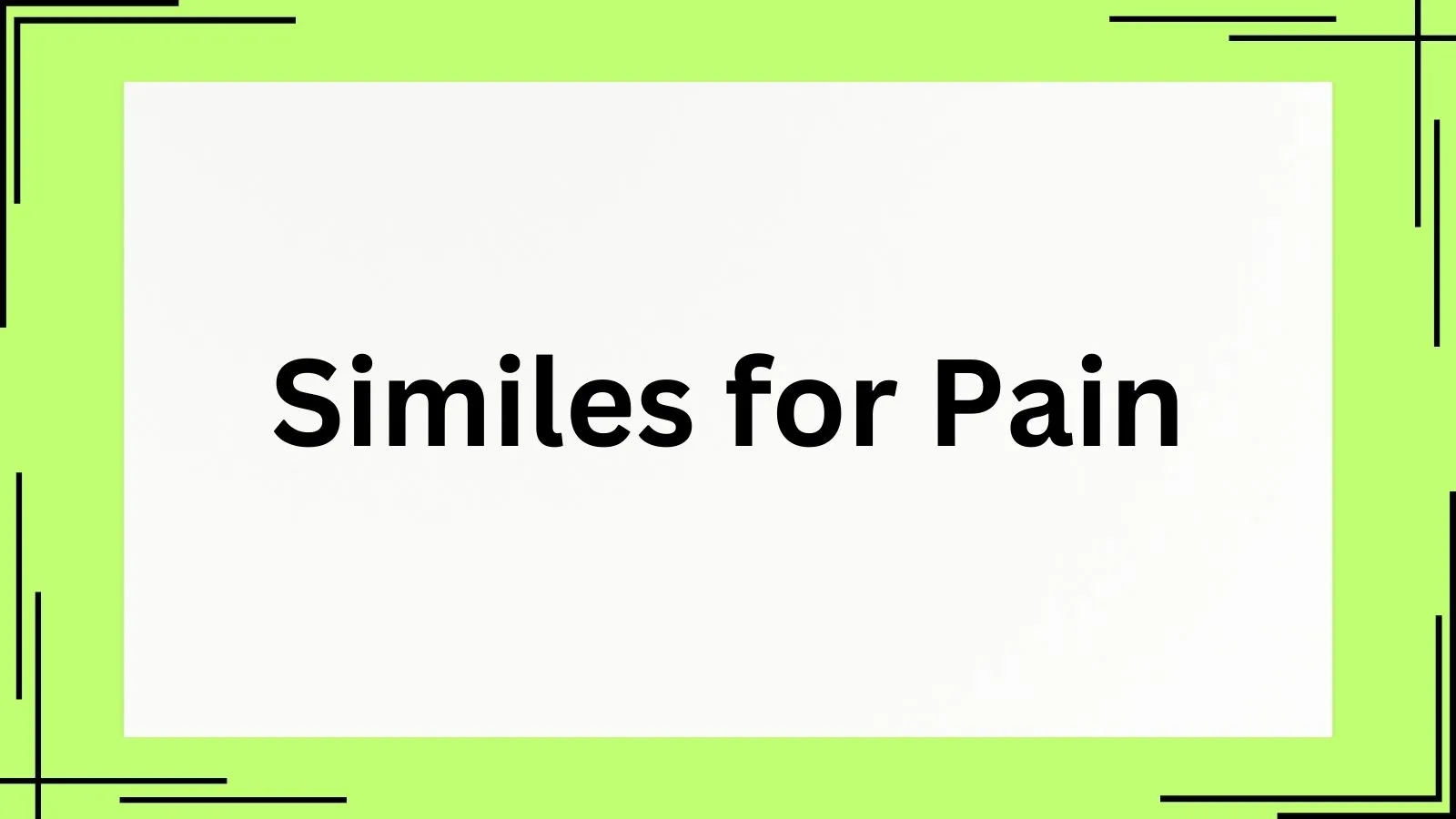Pain is a universal experience, but the way we talk about it can vary significantly depending on the situation, tone, and context.
Whether you’re communicating with a friend, a coworker, or a healthcare provider, the language you use to express the sensation of pain can convey empathy, discomfort, or professionalism.
In this article, we will explore various ways to express pain through similes, categorizing them by tone and purpose.
We will look at both polite and casual alternatives, alongside more formal expressions.
By the end, you will have a wide range of options to express pain depending on the specific context.
What Are Similes for Pain?
Similes are comparisons that describe something by likening it to something else, often using the words “like” or “as.” When it comes to expressing pain, similes help us communicate the intensity or quality of the pain, making it more relatable for the listener.
For example, instead of simply saying “My back hurts,” you might say, “It feels like a thousand needles poking me,” which is a more vivid way to express the same sensation. Similes provide a richer description that can convey emotional undertones, ranging from discomfort to deep agony.
The Importance of Choosing the Right Simile for Pain
Choosing the right simile to describe pain is crucial because it helps set the tone of your message. A casual simile might make light of the situation, while a more professional or polite expression can convey a deeper sense of seriousness. When you are expressing pain to others, the simile you choose can:
- Convey the severity of the pain: Some similes describe mild discomfort, while others can reflect extreme agony.
- Set the tone: A formal or professional expression is more appropriate in medical or workplace settings, while casual similes are better suited for conversations with friends or family.
- Encourage empathy: A well-chosen simile helps others understand and sympathize with what you are experiencing.
Casual Similes for Pain
In informal settings, such as texting or chatting with friends, you might want to use similes that convey your discomfort without sounding too serious. Here are a few examples of casual similes for pain:
- “It feels like I’ve been hit by a truck.”
This expression is commonly used to describe intense physical pain, such as after an accident or intense workout. It conveys the feeling of being overwhelmed or battered. - “It’s like my bones are on fire.”
This simile is perfect for describing sharp, burning sensations, often associated with nerve pain or inflammation. - “It feels like someone’s twisting a knife in my side.”
A vivid way to describe sharp, stabbing pain, often used for chronic conditions or injuries. - “It’s like I’ve been punched in the stomach.”
Great for expressing intense abdominal pain or the sudden onset of discomfort. - “It’s like a bad hangover that won’t go away.”
Ideal for describing dull, lingering pain, like a headache or general body soreness after a long night. - “It feels like my muscles are made of stone.”
This simile works well for muscle soreness or stiffness, like after an intense workout or strain. - “It’s like I’m walking on broken glass.”
Often used to describe foot pain or a sensation of being extremely fragile. - “It feels like a thousand tiny cuts.”
Perfect for describing a general sense of rawness, often used for skin irritation or joint pain. - “It’s like my body is crumbling.”
Used to convey deep, aching pain that affects the whole body, often related to fatigue or chronic conditions. - “It feels like my head is in a vice.”
A simile that vividly conveys the intense pressure and headache associated with migraines or tension headaches.
Polite and Professional Similes for Pain
In more formal contexts, such as in medical settings or professional conversations, it’s important to be mindful of the language you use. Polite and professional similes help convey the seriousness of the situation while maintaining an appropriate tone. Here are some examples:
- “It feels as though there is a constant pressure on my chest.”
Ideal for describing chest pain or tightness, this simile is clear and professional without being overly alarming. - “It feels like there’s a weight on my shoulders.”
Often used to express the burden of stress or muscle tension, this simile is neutral and conveys a sense of discomfort without exaggeration. - “It’s as though my joints are filled with cement.”
This simile is particularly useful for describing stiffness or inflammation in the joints, and it can be used in both medical and professional contexts. - “It feels like I’m walking through molasses.”
This is a great way to describe the sluggishness or heaviness that comes with pain or fatigue, without being too dramatic. - “It’s as if I have a constant ache deep within.”
A way to describe ongoing or chronic pain that feels pervasive and relentless. - “It feels like my muscles are being pulled taut.”
Perfect for describing muscle strain or tension in a more clinical manner. - “It feels as though there’s a weight pressing down on my back.”
Ideal for describing back pain or pressure, often used in medical evaluations. - “It’s like a dull throb that won’t subside.”
A professional and subtle way to describe throbbing pain, useful for migraines or other types of discomfort. - “It feels like there’s a constant tugging sensation in my lower back.”
An apt description for lower back pain that may come with muscle strains or herniated discs. - “It feels like I have a knot in my stomach.”
A delicate way to express anxiety-induced pain or digestive issues.
Tips for Using Similes for Pain in Texts
When texting, you want your similes for pain to be brief but still impactful. Here are 10 user-friendly texting examples that work well for quick, relatable communication:
- “It feels like I got hit by a truck.”
- “Like my body’s been run over.”
- “It’s like a bad migraine that won’t go away.”
- “Feels like I’m walking through sand.”
- “My back hurts like crazy.”
- “It’s like someone’s squeezing my chest.”
- “I feel like I’ve been through a workout marathon.”
- “It’s like a dull ache in my bones.”
- “It feels like my head is going to explode.”
- “I’m so sore, it feels like my muscles are made of lead.”
Conclusion: Choosing the Best Simile for Your Pain
Expressing pain through similes not only helps communicate the intensity of your discomfort but also establishes the tone of the conversation. Whether you’re seeking sympathy from a friend or giving a formal description to a healthcare provider, using the right simile can make your message clearer and more empathetic.
In informal settings, you can opt for more vivid, relatable expressions like “feels like I’ve been hit by a truck,” while in professional contexts, using neutral, more polished phrases like “it feels as though there is constant pressure” might be more appropriate. The key is to match your language with the situation, ensuring your pain is communicated accurately while maintaining the right tone.
With these 15+ similes for pain, you now have a range of expressions to choose from based on your context, audience, and the severity of your discomfort. Remember, similes are powerful tools for storytelling and can help others understand what you’re going through, whether you’re chatting with friends or seeking medical advice.





